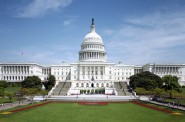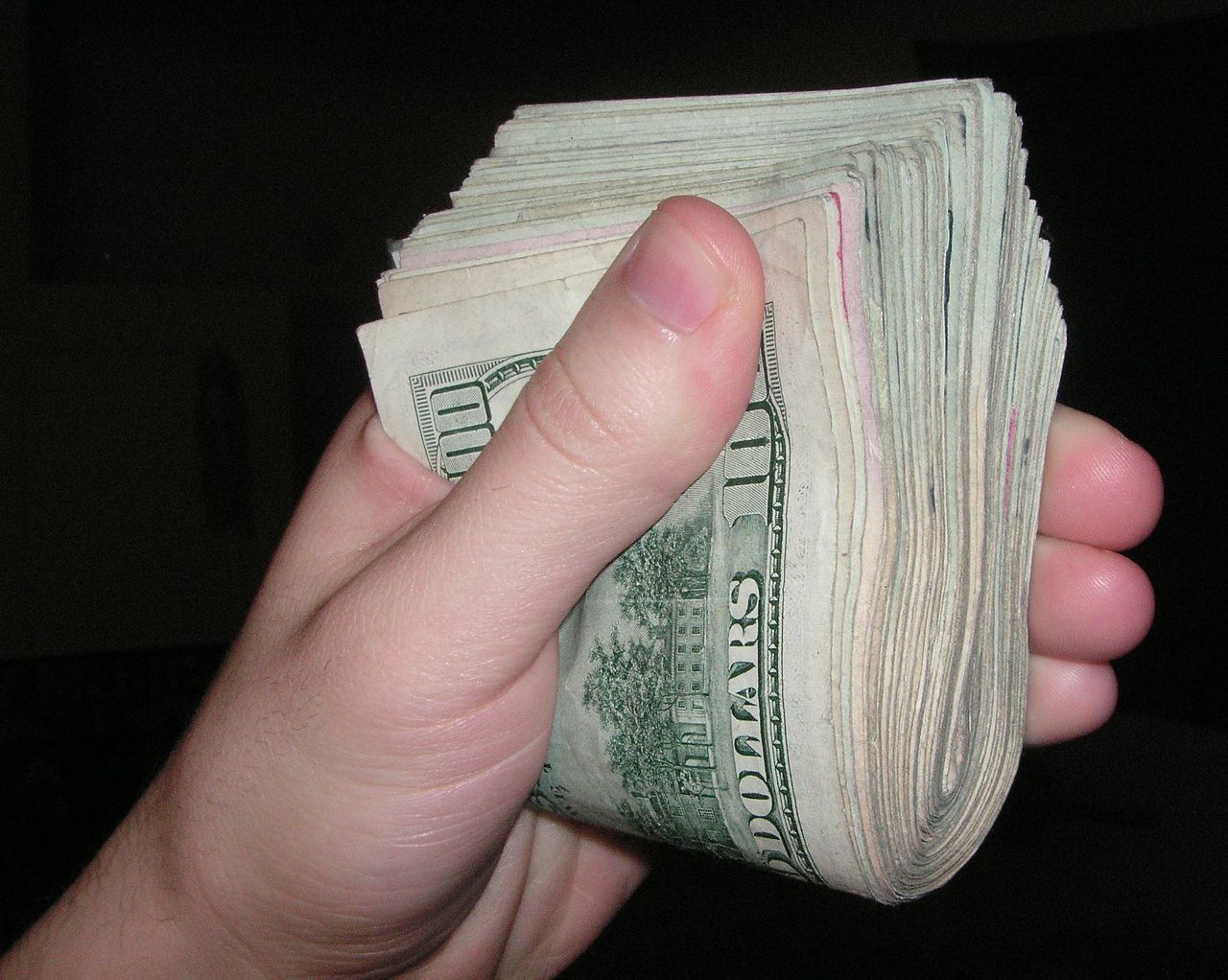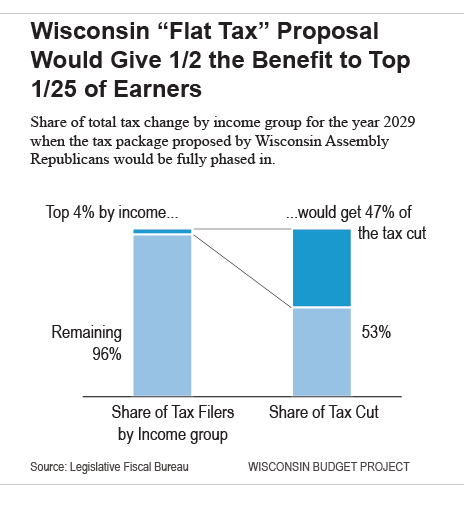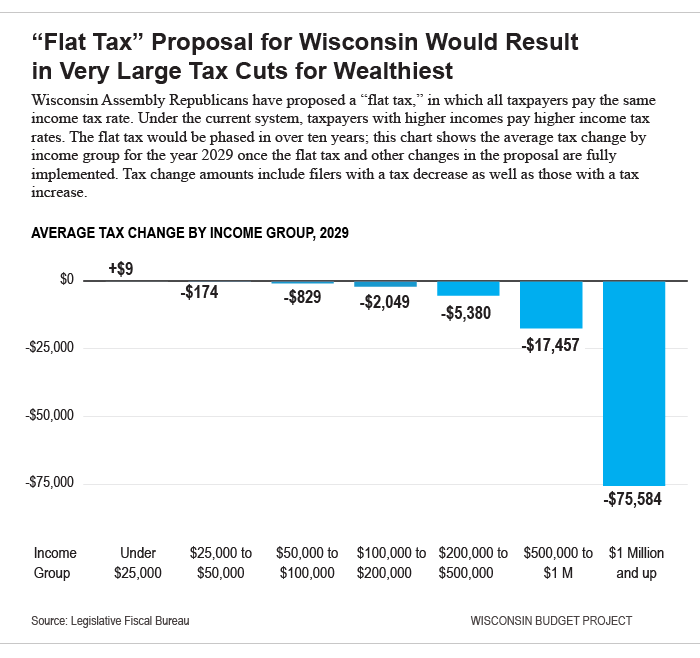Flat Tax Bill Has Massive Impact
Almost half of entire tax cut goes to top 4%; poor get tax increase.
Republicans in the Wisconsin Assembly have proposed a package of tax cuts that would give extremely large tax breaks to earners with the highest incomes, while shutting out Wisconsin residents with low incomes.
The tax package has multiple components, the largest of which is the gradual flattening of the state’s income tax rates. The proposal would reduce income tax rates over ten years to a flat rate of 3.95%. Currently, the bottom income tax rate is 4.0% and the top marginal rate is 7.65%, so the proposal would result in a 0.05 percentage point reduction in the tax rate for income in the bottom bracket, and a 3.7 percentage point reduction for income in the top bracket.
Wisconsin’s income tax system as it currently stands is progressive, meaning that taxpayers with higher incomes pay a higher share of their income in taxes. The progressive nature of the state’s income tax partially – but not completely – offsets the regressive nature of the state’s sales tax and property tax. (For more on how Wisconsin’s state and local tax structure is slanted towards the best off, read Wisconsin’s Tax System Exacerbates Growing Gap between Rich and Everyone Else, April 2017.) If lawmakers change the income tax rate structure from a progressive one to a flat rate, Wisconsin’s tax system will lose the progressive influence provided by the income tax, and our overall state and local tax system will become even more regressive than it is currently.
In addition to phasing in a flat tax, the package includes several other changes to Wisconsin’s tax system, including:
- Eliminating the alternative minimum tax;
- Eliminating a small tax credit for working families;
- Eliminating the measure that taxes money earned from investments at a lower rate than money earned from work;
- Eliminating the married couple credit, which reduces the marriage penalty for the income tax;
- Eliminating the property tax/rent credit for renters; and
- Reducing the itemized deduction credit.
A very large share of the tax cuts included in this package would wind up in the pockets of the best off. Nearly half of the value of the tax cuts – 47% – would go to the top 4% of earners, all of whom have incomes of $200,000 and above. Put another way, about ½ the value of the tax cuts would go to the top 1/25 of earners. The remaining 96% of earners would share the other half of the value of the tax cuts.
In dollar terms, the biggest tax cuts by far would go to the taxpayers with the highest incomes. Taxpayers with incomes of $1 million and up would receive an average annual tax cut of $75,584 when changes included in the tax package are completely implemented in 2029. In contrast, taxpayers who earn between $50,000 and $100,000, an amount typical for a Wisconsin family, would receive an average income tax cut of $829, about 1/90 the size of the average tax cut for millionaires.
Some taxpayers with the lowest incomes would actually pay more in income taxes under this proposal. Taxpayers with incomes of under $25,000 would pay $9 a year more in taxes on average when changes included in the tax package are completely phased in in 2029. More importantly, any income tax cut for low or moderate income Wisconsinites could be more than offset if the sharp reduction in state income tax revenue causes other taxes and fees to increase.
The extremely slanted nature of this proposed income tax cut is a significant drawback to the new tax proposal. But it is not the only drawback: the tax package also comes with an alarmingly high price tag of $2.7 billion a year once it is fully phased in. To put that amount in context, it is more than the state spends on the University of Wisconsin System, the state’s technical college system, and the state’s prison system, combined. Such a large tax cut, targeted at people who are already doing well, would make it much more difficult for Wisconsin to make the investments in schools, health care, and the state’s workforce that help build a strong economy.
Note: Figures in this post are taken from a Legislative Fiscal Bureau letter dated May 9, 2017. The LFB does not include the effects of the proposed tax increase on gasoline in its distributional data. The average tax changes included in this post describes the average across all taxpayers in a particular income group, not just those who received a tax cut.
Wisconsin Budget
-
Charting The Racial Disparities In State’s Prisons
 Nov 28th, 2021 by Tamarine Cornelius
Nov 28th, 2021 by Tamarine Cornelius
-
State’s $1 Billion Tax Cut Leaves Out 49% of Taxpayers
 Sep 21st, 2021 by Tamarine Cornelius
Sep 21st, 2021 by Tamarine Cornelius
-
TANF Program Serves a Fraction of Poor Families
 Aug 30th, 2021 by Jon Peacock
Aug 30th, 2021 by Jon Peacock
























